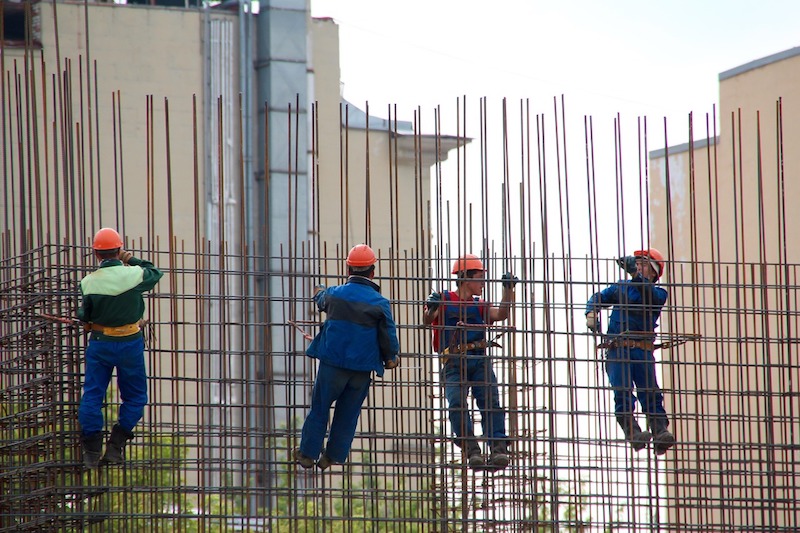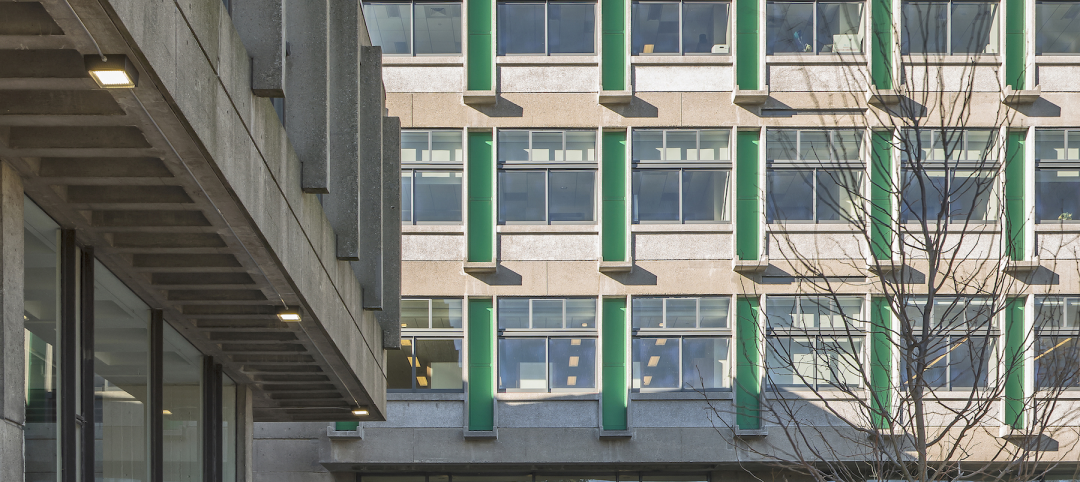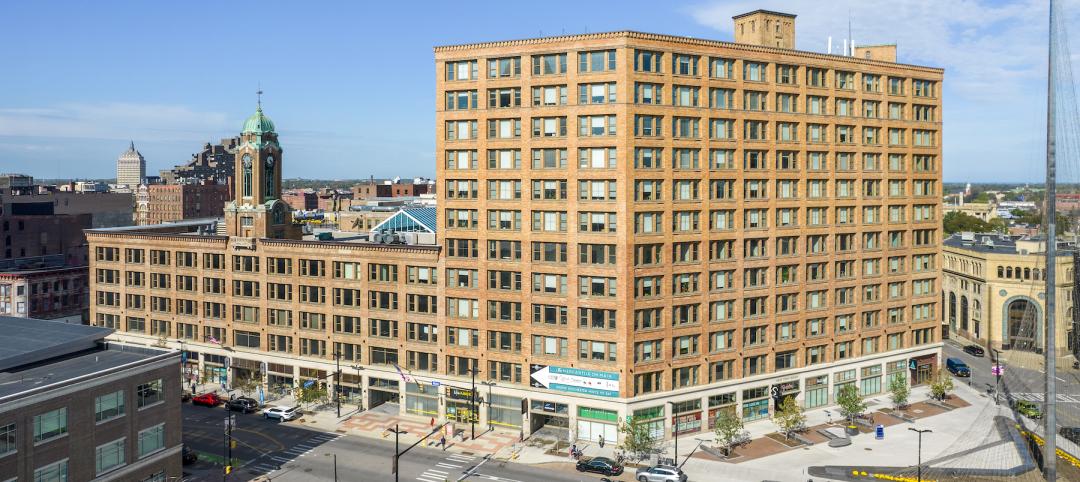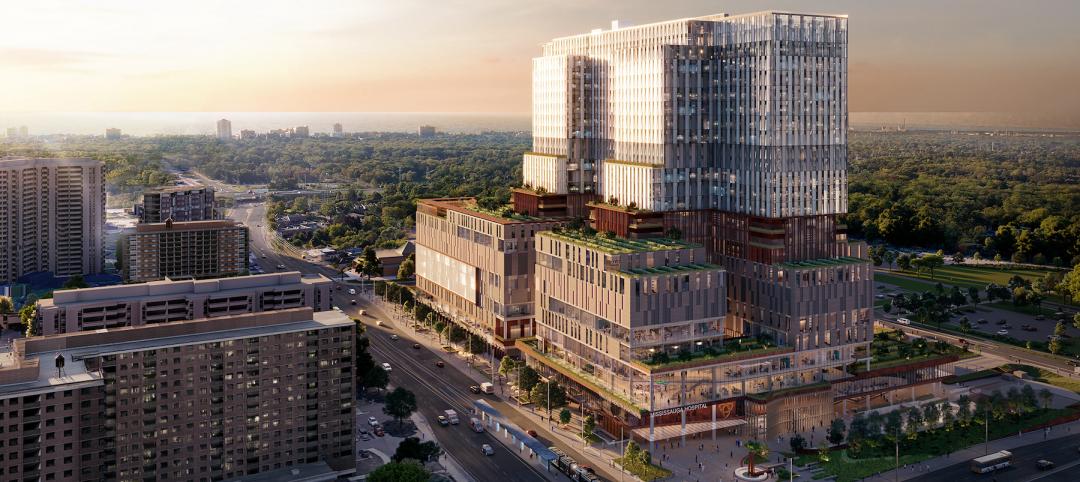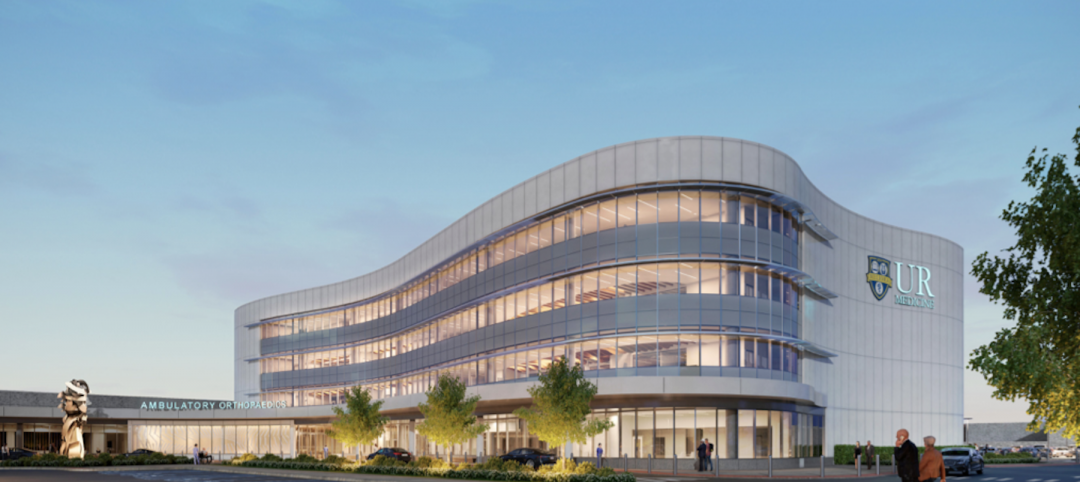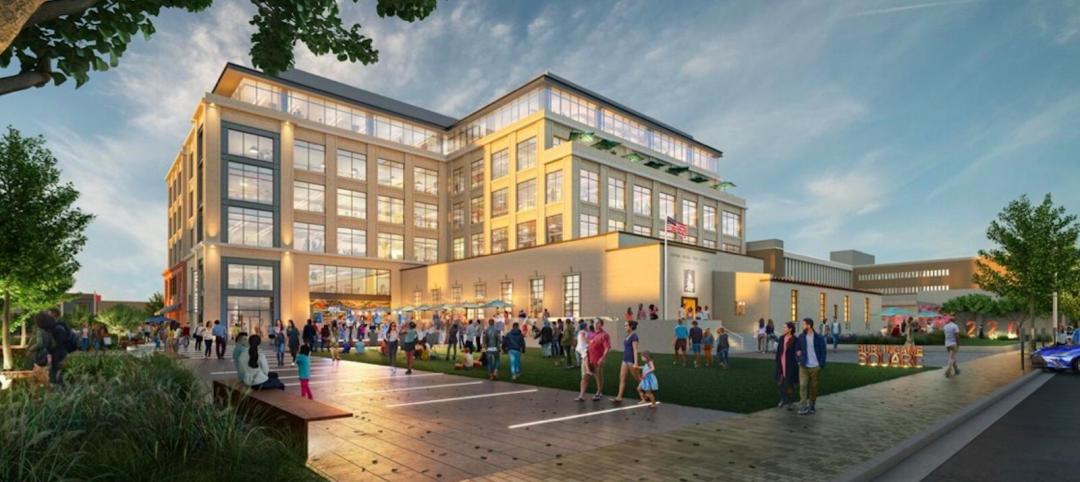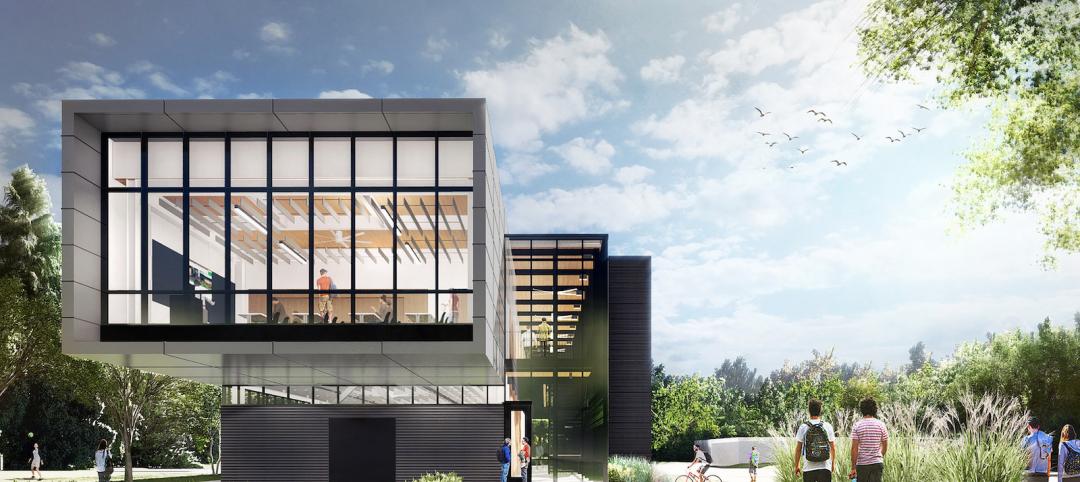The most likely beneficiaries of new infrastructure investment in the U.S. would be the engineering, construction, and industrial manufacturing sectors. And as government officials debate the next major infrastructure stimulus plan, PwC, the accounting and consulting firm, argues in a new study that industrial products and services companies must think proactively about positioning themselves as suppliers, planners, and even investors to help direct which infrastructure projects get funded, and how they are paid for.
The Trump Administration and the leadership of the Democratic Party have each come up with programs to infuse an estimated $1 trillion of infrastructure spending into the economy over the next decade. Those plans roughly align on where that investment is most heavily needed. Where they diverge—or at least are presumed to diverge, as details remain unclear—is primarily over how projects would be funded.
The Democrats’ plan would be chiefly debt financed, but also includes a $10 billion provision for an infrastructure bank to extend loan guarantees and low-cost loans to spur investment. Trump’s plan—which includes paying for a security wall across the U.S.-Mexico that alone could cost up to $25 billion—favors some combination of tax incentives and public-private partnerships, as long as what gets built subscribes to Trump’s “America First” mantra for hiring and product purchasing.
(A stumbling block to new legislation could be Republican budget hawks who have expressed opposition to any plan that isn’t revenue neutral. House Speaker Paul Ryan has gone so far as to state that every dollar of federal money for infrastructure spending must be matched by $40 of private investment. Some Democrats have also objected to the developer-heavy council Trump has assembled to pick and choose projects worthy of stimulus money.)
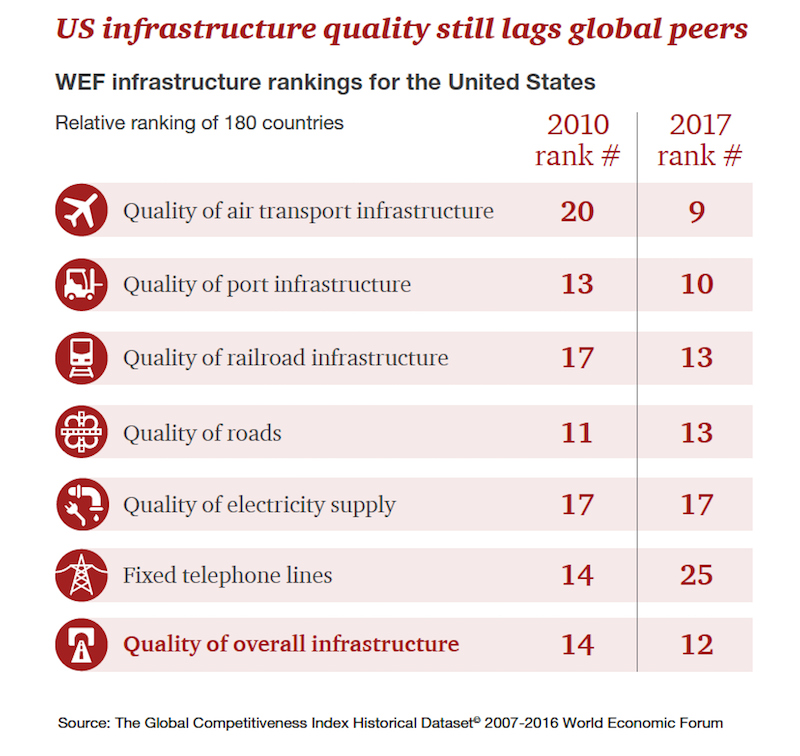
The U.S. seriously lags behind other industrial nations in the quality of its infrastructure. Image: PwC study “What a U.S. Infrastructure Stimulus Could Mean for the Industrial Sector.”
Meanwhile, the clock keeps ticking on the country’s crumbling bridges, roads, tunnels, and airports. The American Society of Civil Engineers (ASCE) estimates $3.3 trillion of investment is needed to maintain, repair and build new infrastructure through 2025, and sees a funding gap of $1.4 trillion to meet those needs. ASCE expects the gap to widen if current public and private investment trends continue unchanged, and further estimate that the economic impact of not filling the gap will sideline a potential $3.9 trillion GDP boost and 2.5 million jobs.
The public wants dramatic action to be taken, but continues to send out mixed signals about stimulus spending: PwC quotes a recent poll, conducted by Politico and Harvard’s T. H. Chan School of Public Health, which found 61% of Americans favor major new tax credits for business to build roads, bridges, waterways, airports and other infrastructure, while 75% says it was important for these projects to be federally funded.
PwC, though, thinks the time is “ripe” for more P3 activity in the U.S., partly because many states, restricted by balanced budget mandates and their unwillingness to raise taxes, simply can’t afford to take on big projects.
The question, though, is how to get more investors into the game. Through mid 2016, infrastructure funds that target North American assets were sitting on $75 billion in unspent capital. “The attractiveness of U.S. infrastructure [as an investment] needs to improve,” observes PwC.
The accounting firm thinks it “makes sense” to focus more on projects that enhance the America’s global competitiveness. In the latest World Economic Forum’s annual Global Competitive Index, a global ranking of the quality of the business environment, U.S. infrastructure lags other economies across several categories, ranking 12th overall, 13th in quality of roads, and ninth in air transport. Since 1980, public spending in transportation and water infrastructure, as a percentage of GDP, has held at around 2.5% compared to its 1959 peak of 3%. “The trend is hard to dislodge,” states PwC.
The irony is that greater investment pays dividends, if the Obama Administration’s $831 billion stimulus package through the American Recovery and Reinvestment Act of 2009 is any barometer. The Congressional Budget Office (CBO) estimated that real GDP in 2010 was between 0.7% and 4.1% higher and that employment was between 700,000 and 3.3 million jobs greater (measured in employment years) than had the stimulus not been carried out. Over the 2009–2011 period, the number of jobs saved or created by ARRA investment was estimated by CBO to be between 1.4 million and 6.8 million.
PwC asserts that if the Trump Administration dedicated $100 billion per year to rebuilding infrastructure, job creation and business activity in the industrial sector would inevitably follow. “For a sustained effect, a strong emphasis should be placed not only on short-term jobs creation and economic stimulus, but also on long- term impact on productivity rates, sustainability and efficiencies that have strong fiscal multiplier effects. For example, embedding ‘smart’ technology in all new infrastructure is critical, to ensure that infrastructure assets are ‘future proof.’ ”
Perhaps the most controversial part of PwC’s report—and one Trump and many of his supporters would find hard to swallow—is its business-centric view that any infrastructure stimulus plan shouldn’t get too hung up on how many jobs it generates.
“Considering the ongoing shifting nature of jobs,” PwC continues, “as manufacturers adopt advanced manufacturing technologies is just as important as—and perhaps more important than—the number of jobs in the industrial labor force.”
Related Stories
Sponsored | BD+C University Course | May 10, 2022
Design guide for parapets: Safety, continuity, and the building code
This course covers design considerations for parapets. The modern parapet must provide fire protection, serve as a fall-protective guard, transition and protect the roof/facade interface, conceal rooftop equipment, and contribute to the aesthetic character of the building.
Reconstruction & Renovation | May 4, 2022
AIA course: Concrete buildings — Effective solutions for restoration and major repairs
The history of concrete construction between 1950 and 1970 offers architects and construction professionals a framework for how to rehabilitate these buildings today using both time-tested and emerging technologies. This course, worth 1.0 AIA LU, was authored by Henry Moss, AIA, LEED AP, Principal with Bruner/Cott Architects.
Multifamily Housing | Apr 7, 2022
Ken Soble Tower becomes world’s largest residential Passive House retrofit
The project team for the 18-story high-rise for seniors slashed the building’s greenhouse gas emissions by 94 percent and its heating energy demand by 91 percent.
Reconstruction & Renovation | Mar 28, 2022
Is your firm a reconstruction sector giant?
Is your firm active in the U.S. building reconstruction, renovation, historic preservation, and adaptive reuse markets? We invite you to participate in BD+C's inaugural Reconstruction Market Research Report.
Projects | Mar 18, 2022
Former department store transformed into 1 million sf mixed-use complex
Sibley Square, a giant mixed-use complex project that transformed a nearly derelict former department store was recently completed in Rochester, N.Y.
Projects | Mar 18, 2022
Toronto suburb to build the largest hospital in Canada
A new hospital in Ontario will nearly triple the care capacity of its existing facility—becoming the largest hospital in Canada.
Projects | Mar 15, 2022
Old Sears store will become one of the largest orthopaedics outpatient facilities in the Northeast
A former Sears store in Rochester, N.Y., will be transformed into one of the largest orthopaedics outpatient facilities in the Northeast.
Projects | Mar 3, 2022
Move, lift, restore: Repurposing a former post office near San Francisco
In mid-February, a construction crew began lifting a 1940s post office building located in Burlingame, Calif., on the San Francisco Peninsula.
Higher Education | Mar 1, 2022
SRG Partnership designs a nautically inspired space for maritime science
A community college in Oregon has begun construction on a new building devoted to maritime science. With it, the school hopes to solidify its position as a major industrial and marine technology center in the Pacific Northwest.
Sponsored | BD+C University Course | Feb 17, 2022
Metal roofing trends
New ideas in design and constructability are radically changing how metal systems are used as roofing for commercial and institutional buildings. Behind the investment in these new kinds of expressions and construction approaches is a growing interest in improved performance and reduced environmental impact. Metal roofing systems can cut cooling and heating loads significantly, according to the EPA.


